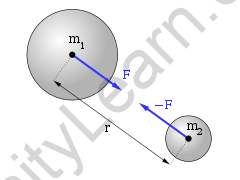Table of Contents
All things are drawn to Earth by an unseen force of attraction. One such attraction force is known as gravitation or gravitational pull. This same objects move as a result of the Earth’s gravitational forces or gravitational pull, which is nothing more than a force of attraction. The gravitational force or gravity of the earth is really what keeps you here and pulls you down. The gravitational force seems to be essentially a central force that operates along a line connecting the centres of two bodies. Whenever an object falls freely towards the earth, the direction of motion of the object never changes. However, the magnitude of velocity changes due to the attraction of the earth.
In general, the gravitational constant (also known as the universal gravitational constant, the Newtonian constant of gravitation, or the Cavendish gravitational constant), denoted by the capital letter G, is an empirical physical constant used in Sir Isaac Newton’s law of universal gravitation and Albert Einstein’s general theory of relativity to calculate gravitational effects. As per the laws, just about everybody in the universe attracts it with a force that is directly proportional to the product of their masses and inversely proportional to the square of the distance between them. This same force acts along the line that connects the two bodies.

The gravitational constant is just a defining constant in some natural unit systems, particularly geometrized unit systems like Planck and Stoney. Once expressed in terms of such units, the gravitational constant has a numeric value of 1 or something close to it. Because of the significant uncertainty in the measured value of G in terms of other known fundamental constants, there will be a similar level of uncertainty in the value of several quantities when expressed in such a unit system.
In physics, the gravitational constant is being used to calculate the gravitational force of attraction. The Universal law of gravitation is really a significant breakthrough in the field of physics. This elucidates the relationship between mass and force. The gravitational constant has been defined as the constant that relates the force exerted on objects to their mass and distance apart.
Dimensional Formula of Universal Gravitational Constant
We know, Force = G × m1 × m2 × [r2]-1
Otherwise, G = Force × r2 × [m1 × m2]-1 . . . . . (1)
Here, G = Universal Gravitational Constant
Then, the dimensions of,
Mass = [M1 L0 T0] . . . . (2),
Radius = [M0 L1 T0] . . . . (3),
Force = [M1 L1 T-2] . . . . . (4),
When substituting equation (2), (3) and (4) in equation (1) we get,
Universal Gravitational Constant = Force × r2 × [m1 × m2]-1
Otherwise, G = [M1 L1 T-2] × [M0 L1 T0]2 × [M1 L0 T0]-1 × [M1 L0 T0]-1 = M-1 L3 T-2.
Thus, the Universal Gravitational Constant can be dimensionally represented as [M-1 L3 T-2].
FAQs:
Q. What is the Gravitational Constant?
Ans: The gravitational constant has been defined as the constant that relates the force exerted on objects to their mass and distance apart.
Q. Give the dimensional formula of Universal Gravitational Constant?
Ans: Universal Gravitational Constant can be dimensionally represented as [M-1 L3 T-2].




